On This Page: [hide]
Why dive into the ecommerce world with a Shopify store in 2024 and beyond? Shopify’s user-friendly interface and comprehensive toolkit simplify the online selling process, making it an ideal choice for both beginners and experienced merchants.
This article explores the potential of starting a Shopify store, highlighting its growth prospects, ease of use, and the trends shaping online retail. Whether you’re pinpointing your niche or ready to launch, understanding Shopify’s ecosystem can set you on a path to success in the digital marketplace.

Why Start a Shopify Store in 2024? Understanding Its Potential
Entering the digital market with a Shopify store in 2024 offers an unprecedented opportunity for entrepreneurs and small businesses alike. This year, the global ecommerce landscape continues to thrive, presenting a clear path for online retail success.
Shopify, a platform encourages even novices to dive into ecommerce with confidence. Its user-friendly nature and comprehensive suite of tools simplify the process of setting up, managing, and scaling online stores. Furthermore, the anticipated growth in the ecommerce market underscores the potential for high returns on investment for Shopify store owners.
What Makes Shopify a Leading E-commerce Platform?
Shopify distinguishes itself as a leader in the ecommerce platform space due to its emphasis on user experience and scalability. Its design caters to users at all skill levels – from those taking their first steps in online sales to seasoned merchants aiming to expand their reach.
Shopify’s intuitive interface, extensive theme selection, and numerous customization options allow merchants to create a store that truly reflects their brand without needing extensive web development skills. In addition, features like seamless integration with third-party apps and marketplaces broaden the scope of what businesses can achieve on the platform.
Moreover, Shopify’s support ecosystem ensures that sellers have all the guidance and resources needed to navigate the digital marketplace successfully.
The Growth of E-commerce: Trends to Watch
The ecommerce sector is set to continue its exponential growth trajectory into 2024 and beyond. Several key trends are shaping the future of online retailing, including the rise of mobile commerce, the importance of sustainability in consumer choices, and the increasing use of artificial intelligence for personalized shopping experiences.
Mobile shopping, in particular, is becoming increasingly prevalent, with more consumers using smartphones to browse and purchase products. This trend emphasizes the necessity for online stores to ensure their websites are optimized for mobile devices.
Also, there’s a growing expectation for businesses to adopt eco-friendly practices and offer sustainable products, reflecting consumers’ heightened environmental consciousness.
Moreover, leveraging AI technology offers the potential to significantly enhance customer engagement and sales by providing highly customized shopping experiences.
These trends not only highlight areas of opportunity for new Shopify store owners but also signify the evolving demands of the ecommerce industry.
Step 1: Pinpoint Your Niche for a Shopify Store
Starting your online venture begins with identifying the perfect niche for your Shopify store. This initial step is crucial as it lays the foundation for your business, determining its trajectory and potential for success.
A well-chosen niche not only attracts a specific target market but also sets the stage for building a loyal customer base. Consider combining your passions with market needs to find a niche that is both enjoyable and lucrative.
How to Choose a Profitable Niche in 2024
Choosing a profitable niche requires a blend of personal interest, market demand, and strategic thinking. Begin by listing your hobbies, interests, and expertise areas. This personal connection ensures that you are engaged and motivated in the long run. Next, conduct a thorough market analysis to validate consumer interest and viability. Use tools like Google Keyword Planner or Ahrefs to assess search volumes and competition levels for your potential niche.

In addition, look into long-term trends to ensure that your chosen niche has staying power. Evergreen niches, such as health, relationships, money, beauty and skincare, and pet care, offer resilience against market fluctuations. However, don’t shy away from narrowing down to cater to more specific interests or emerging trends, as long as there’s a clear, sustainable demand.
Examples of Successful Shopify Stores in Various Niches
Learning from successful Shopify stores can provide valuable insights into what works in different niches.
For instance, fashion and beauty stores often excel through strong branding and influencer collaborations.In contrast, tech gadget stores might focus on the latest innovations and offer detailed product guides or reviews.

Pet care shops can succeed by fostering a sense of community among pet owners, sharing engaging content and creating a platform for peer support alongside selling products.
Analyze these stores to understand how they position themselves, interact with their audiences, and differentiate from competitors.
To further inspire your journey, consider stores that have excelled by drilling down into sub-niches.
Sustainable fashion is a brilliant example where stores not only offer eco-friendly products but also educate their audience on the importance of sustainability.
This approach not only sells products but also builds a brand ethos that resonates deeply with their target market.
Observing these strategies in action can help you refine your own niche selection and market approach.
Step 2: Register and Set Up Your Shopify Account
Embarking on the journey to create an online store starts with a simple yet crucial step: registering for a Shopify account.
This process is streamlined to ensure that even those new to ecommerce can navigate it easily. Begin by visiting Shopify’s official website and clicking on the “Start free trial” button.
This trial period is a golden opportunity to explore the vast functionalities of Shopify without any financial commitment.
Here, you will provide some basic information about yourself and your envisioned store, including your email, a secure password, and most importantly, your store’s name.
This name not only identifies your brand but also becomes part of your default Shopify domain, making it essential to choose something memorable and reflective of your business vision.
A Beginner’s Guide to Shopify Signup Process
The signup process is designed to be intuitive, asking you a few straightforward questions about your store. These questions help Shopify customize the setup experience to better suit your business structure and goals.
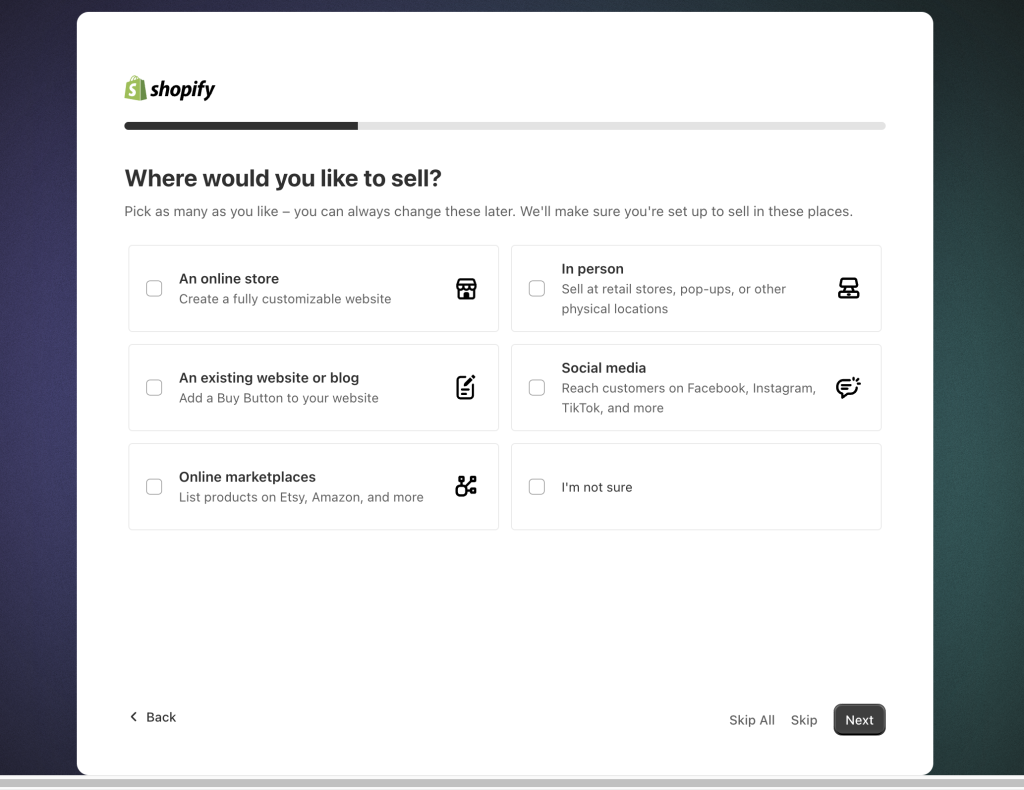
Whether you have detailed plans or are still solidifying your idea, Shopify’s setup process adapts to your needs. After submitting your store’s name and personal details, you will be directed to your Shopify admin dashboard. This is your control center, where the transformation of your business idea into a digital reality begins.
Customizing Your Shopify Admin Dashboard
Once inside your Shopify admin dashboard, you’re met with an array of tools and features at your fingertips. These are designed to cater to every aspect of building and managing your online store. Initially, it may seem overwhelming, but Shopify’s dashboard is crafted for ease of use, guiding you through each necessary step.
From selecting a theme that resonates with your brand’s aesthetic to adding your first product, the dashboard serves as your guide through the ecommerce journey.
One of the first steps recommended is acquiring a custom domain to elevate your store’s professionalism and aid in brand recognition. A domain that mirrors your brand not only lends credibility but also plays a crucial role in SEO, making your store more discoverable.
Furthermore, diving into the theme library unveils a selection of designs ranging from minimalist to intricate, ensuring there’s something that perfectly encapsulates your brand’s essence. With your domain and theme set, the next phase involves detailing your products, setting up payment options, and outlining shipping logistics, among other operational details, all from within the dashboard’s organized interface.
Step 3: Design and Theme Selection for Your Shopify Store
Selecting the right theme for your Shopify store is more than just about aesthetics; it’s about creating a user experience that aligns with your brand’s identity and meets your customers’ expectations. With Shopify’s extensive theme store, finding the perfect theme can seem like finding a needle in a haystack. But fear not, with a strategic approach, you can easily identity a theme that not only looks great but also functions seamlessly for your online business.
How to Select the Perfect Shopify Theme
The key to finding the perfect Shopify theme lies in clarity about your brand’s needs, your design preferences, and your customers’ shopping habits. Start by assessing your product catalog size and the type of products you’re selling. This will help you determine whether you need a theme that can handle a large inventory or one that focuses more on visual storytelling for a smaller catalog.
- Theme Responsiveness: Ensure the theme is fully responsive. This means your online store will look good on any device, providing a smooth shopping experience whether your customers are on a desktop or a mobile phone.
- Style and Functionality: Look for themes that match your brand’s style and voice. If your brand is about sophistication and elegance, a clean and minimalist theme might be the best fit. Also, consider the functionalities you need – whether it’s advanced filtering options, quick view capabilities, or integrated social media feeds.
- Customer Experience: Pay close attention to navigation and search capabilities. A theme that allows for easy navigation and has a robust search function can significantly enhance the shopping experience, encouraging customers to explore more of your products.
- Social Proof and Engagement: Themes that facilitate easy integration of reviews and allow for customer engagement through comments or social shares can help build trust and community around your brand.
While exploring options, utilize theme reviews and previews to gauge how well a theme could align with your vision. Don’t hesitate to experiment with different themes through trial versions provided by Shopify.
Customization: Turning a Theme Into Your Brand
Once you’ve selected a theme, the next step is customization. Customizing your Shopify theme is about more than adding your logo and choosing brand colors. It’s about transforming a generic template into a unique online space that embodies your brand and connects with your target audience.
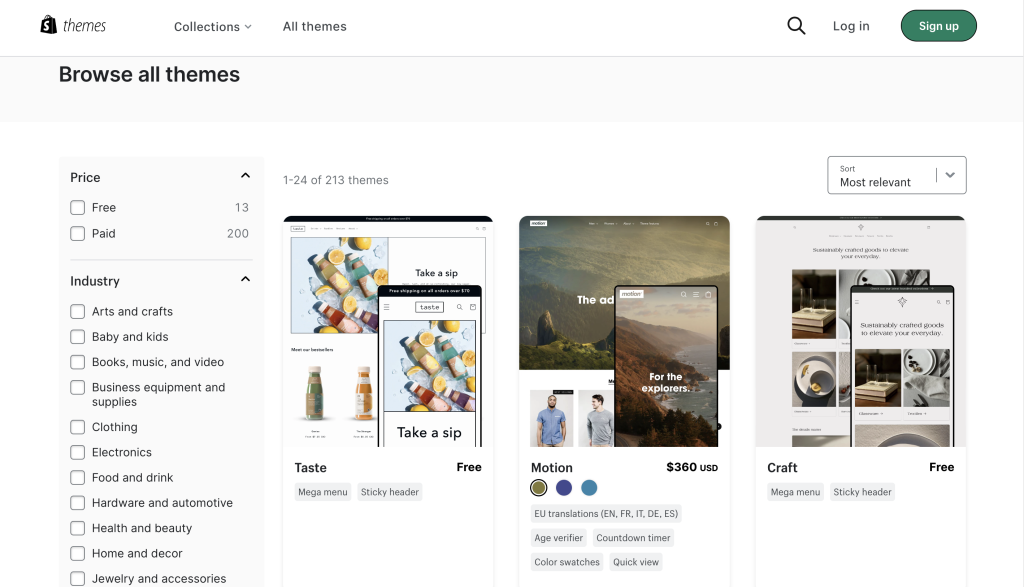
- Start with Basics: Basic customization options like changing fonts, colors, and adding your logo are straightforward. These should align with your brand’s visual identity to ensure consistency across all customer touchpoints.
- Visual Assets: Use high-quality images for your products and banner areas. Quality visuals can communicate the value of your products and help to convey your brand’s story.
- Homepage Layout: Customize the homepage to showcase your bestsellers, new arrivals, or any ongoing promotions. A well-structured homepage can direct visitor’s attention to what’s important and can significantly impact conversion rates.
- Custom Features: Depending on your theme, you may have access to custom features and advanced modifications. This could range from unique product display options to custom checkout processes. If you lack technical skills to make these adjustments, consider hiring a Shopify Expert to help you.
Remember, while customization can set your store apart, maintaining simplicity in design and navigation ensures that your site remains accessible and easy to use for your customers. Test your site’s functionality regularly to ensure a seamless shopping experience.
In conclusion, selecting and customizing your Shopify theme is a crucial step in your online business journey. It sets the foundation for your brand’s online presence and plays a significant role in how your customers perceive and interact with your brand.
By choosing a theme that resonates with your brand identity and customizing it to reflect your unique story and value proposition, you create a compelling online space that attracts and retains customers.
Step 4: The Art of Adding Products to Your Shopify Store
Adding products to your Shopify store marks a significant milestone in the journey of launching your ecommerce business. This step involves more than just listing what you intend to sell; it encompasses a comprehensive strategy to ensure your products are presented in a manner that attracts and convinces potential customers.
Must-Have Product Information for Your Listings
To construct a product listing that stands out, you need to focus on a few critical elements. Firstly, the product title should be clear, descriptive, and incorporate keywords that potential customers might use in their search queries.
For descriptions, highlight the features and benefits in an easy-to-digest format, including bullet points to break down information. This approach helps shoppers understand the value of your products quickly. Remember to specify the material, dimensions, and other essential product details that a customer might need before making a purchase decision.
- Product Titles: Aim for clarity and relevance.
- Descriptions: Use bullet points for features and benefits.
- Material and Dimensions: Provide precise product specifications.
The Importance of High-Quality Product Images

Product images play a pivotal role in online shopping experiences. High-quality, vibrant photos can significantly impact a buyer’s decision-making process. It’s crucial to capture multiple angles and usage scenarios of the product to provide a comprehensive visual experience.
This can include using a simple background to enhance focus on the product and employing models for wearable items to offer a realistic view of how the product fits.
- Lighting and Background: Ensure photos are well-lit with a non-distracting background.
- Multiple Angles: Show your product from various perspectives.
- Real-life Usage: Incorporate images with models if applicable.
SEO Practices for Product Descriptions That Sell
Optimizing your product descriptions with relevant keywords is essential for improving your store’s visibility in search engine results. Conducting keyword research to understand what potential buyers are searching for can guide you in crafting both titles and descriptions that match these queries.
However, avoid keyword stuffing; rather, integrate them smoothly into your text to maintain a natural and appealing narrative. Remember, your ultimate aim is to connect with your audience by addressing their needs and interests, providing them with all the information they need to make an informed decision seamlessly.
- Keyword Research: Identify and use relevant keywords naturally.
- Engaging Content: Write with the customer’s needs and interests in mind.
- Simple Language: Keep descriptions accessible and easy to understand.
By focusing on these essential aspects when adding products to your Shopify store, you’ll not only enhance the appeal of your listings but also improve your store’s searchability and user experience. Striking the right balance between informative and SEO-friendly content can significantly influence your store’s success.
Step 5: Integrating Payments and Setting Up Checkout
Integrating a payment system and setting up an efficient checkout process is crucial for the success of any online store. This stage in setting up your Shopify store involves selecting a suitable payment gateway and customizing the checkout experience to make it as straightforward as possible for your customers.
By focusing on these aspects, you ensure not only the security of transactions but also enhance customer satisfaction by providing a seamless shopping experience.
Choosing the Right Payment Gateway for Your Store
Choosing the right payment gateway is vital for your online business. A payment gateway facilitates the processing of customer payments in an online store. Shopify supports several options, including its own Shopify Payments, PayPal, Stripe, and others, all capable of handling major credit cards.
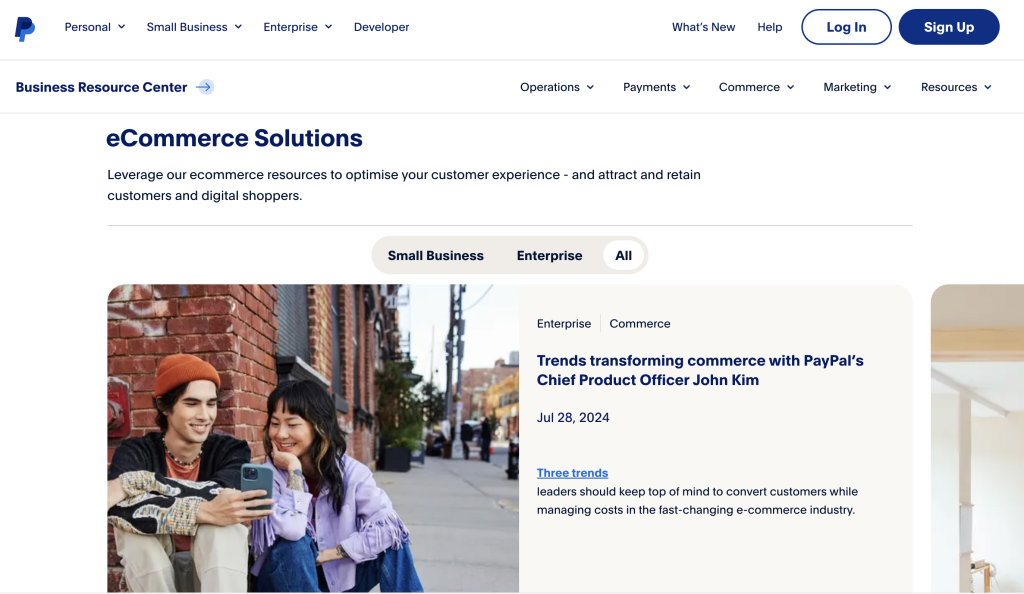
When selecting a payment gateway, consider the following:
- Transaction Fees: Compare the fees associated with different gateways. Remember, lower fees can significantly affect your margins.
- Customer Preferences: Opt for a gateway that offers the payment options your customers prefer.
- Geographical Availability: Ensure the gateway supports transactions in your store’s location as well as your target markets.
- Security: Security is paramount. Look for gateways with robust security measures to protect customer information.
- Setup and Operational Ease: Choose a gateway that’s easy to integrate and manage on your Shopify dashboard.
Don’t forget to conduct a test transaction to confirm everything is working as it should before launching your store.
Streamlining the Checkout Process for Customers
Streamlining the checkout process is about reducing friction to ensure customers can complete their purchases with ease. Here’s how you can customize your Shopify checkout for the best results:
- Customer Contact Options: Let your customers choose their preferred means of communication (email or SMS text messages) for order confirmations and updates.
- Form Customization: Simplify your checkout forms. Request only essential information, allowing customers to complete their transactions quickly.
- Order Processing: Offer options that speed up the ordering process, such as saving customer information for future purchases.
- Addressing Abandoned Checkouts: Set up automated reminder emails for customers who leave your site without completing their purchase.
- Guest Checkout: Enable customers to check out without creating an account, which can greatly reduce checkout abandonment.
Ultimately, a fluid checkout experience that minimizes barriers to purchase can significantly increase conversion rates. Remember, making small adjustments to streamline the checkout process not only enhances customer satisfaction but also builds trust in your brand. By implementing a secure, efficient payment and checkout system, you pave the way for a successful and resilient online business.
Step 6: Organizing Shipping and Delivery Options
Organizing your shipping and delivery options is a crucial step that can significantly influence your ecommerce business’s operational efficiency and customer satisfaction. By setting up coherent shipping strategies, you provide clarity and convenience for your customers, which can lead to increased loyalty and repeat purchases.
This process involves delineating your shipping zones, establishing shipping rates, and possibly integrating shipping apps and solutions that streamline your operations.
Setting Up Shipping Zones and Rates
Shipping zones are geographic areas where you offer specific shipping services. Each zone can have its own set of shipping rates and options, allowing for a customized approach that caters to the diverse needs of your customer base.
Establishing shipping zones helps in strategizing your shipping by region, potentially reducing costs and improving delivery times. Below is a simplified guide on setting up shipping zones and rates:
- Access Shipping Settings: In your Shopify admin dashboard, navigate to “Settings” then click on “Shipping and delivery”.
- Manage Shipping Rates: Choose a shipping profile to edit and select “Manage rates”.
- Add Shipping Zones: Click “Create shipping zone,” name the zone (e.g., “Domestic” or “International”), and select the countries or regions to include.
- Define Shipping Rates: Within a zone, click “Add rate” to establish your pricing. Here, you can opt for setting your own rates or applying carrier/calculated rates. Specify the conditions like weight or price thresholds that these rates will apply to.
- Save Your Settings: Remember to save your configurations to apply the new shipping rates and zones.
Adjusting these settings periodically allows you to stay competitive and adaptable to market changes or operational needs.
Exploring Shipping Apps and Solutions for ShopifyIntegrating shipping apps and solutions into your Shopify store can significantly enhance your operational workflow and customer experience. These tools automate many aspects of the shipping process, from generating shipping labels to tracking packages in transit. Here’s how to leverage these solutions effectively:
- Automation: Look for apps that automate repetitive tasks. Efficiency in generating shipping labels, automated tracking updates to customers, and simplified returns are key features to consider.
- Carrier Integration: Ensuring that your chosen solution integrates well with major carriers provides flexibility and real-time access to shipping rates, helping you offer competitive pricing.
- Customization: Shipping solutions with customizable aspects, such as branding your tracking pages or delivery emails, can enhance the customer experience and contribute to your brand identity.
- Scalability: Your shipping solution should grow with your business. Seek options that can handle an increasing volume of orders without compromising speed or accuracy.
Incorporating the right shipping apps and solutions mitigates manual errors, saves time, and often results in cost benefits. By streamlining shipping operations, you can focus more on scaling your business and less on the intricacies of logistics management.
Step 7: Mastering the Tax Setup on Shopify
Understanding and applying the correct tax rates to your Shopify store is crucial for compliance and customer satisfaction. This process can seem overwhelming, but with the right guidance, it becomes a straightforward component of managing your online business. In this comprehensive guide, we’ll dive into how you can automate your store’s tax calculations and navigate international taxes and regulations with confidence, ensuring you’re up-to-date with local and global tax obligations.
Automating Your Store’s Tax Calculations
Automating tax calculations on Shopify can significantly reduce the manual workload and minimize errors. Shopify’s built-in features provide automatic tax calculations based on your store’s location, taking the hassle out of staying compliant with local tax laws.
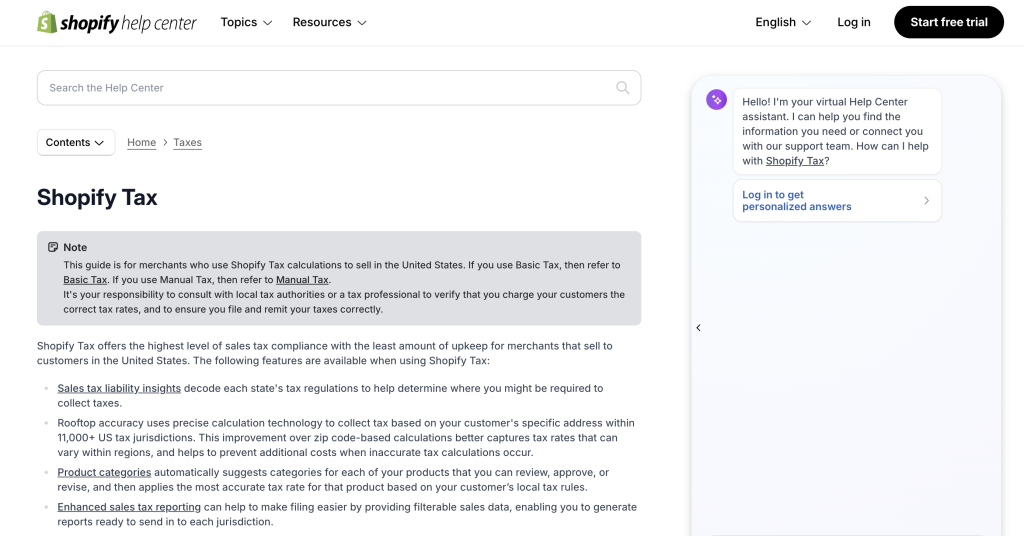
To activate this feature:
- Navigate to the “Settings” menu in your Shopify admin dashboard and select “Taxes and duties.”
- In the “Tax regions” section, find your region and click “Set up.”
- For regions that support it, enable the “Automatically calculate tax” option to have Shopify calculate the tax rates in real-time.
- If you prefer to include taxes in your product prices, select the “All prices include tax” box to make pricing transparent for your customers.
- Remember to click “Save” to apply your configurations.
This automation helps ensure that the correct tax rates are always applied, keeping your business compliant and reducing the time you spend on administrative tasks.
Navigating International Taxes and Regulations
For businesses selling internationally, understanding and applying the correct tax rates can be particularly challenging due to varying regulations across different countries. Here’s how you can manage this effectively on Shopify:
- First, assess the regions where you need to collect taxes. Consulting with a tax professional can provide insights into specific obligations in these areas.
- Within Shopify, go to “Settings > Taxes” and select the relevant regions under the “Manage sales tax collection” section.
- Shopify allows you to set up tax rates for each country or region you’re selling to. If needed, enter custom tax rates for specific regions.
- It’s also possible to manage tax-exempt products or customers by overriding default tax settings in Shopify, offering flexibility for unique situations.
- Ensure your tax number is entered correctly in each region’s settings to maintain transparency and compliance.
By leveraging Shopify’s tax management features, you can streamline the process of meeting international tax requirements, reducing the risk of compliance issues and focusing on global expansion.
Successfully managing your store’s tax setup requires a balanced approach that combines the use of technology with a clear understanding of local and international tax laws.
Shopify’s tax settings simplify this process, allowing you to automate calculations and adapt to various tax regulations easily. Just remember, consulting with a tax professional can provide additional clarity and ensure you’re fully compliant, safeguarding your business against potential legal challenges.
Step 8: Essential Pages Your Shopify Store Needs
When launching your Shopify store, remember that the devil is in the details. Essential pages such as ‘About Us’, ‘Contact’, and various policy pages are not just formalities; they are integral components that foster trust, transparency, and legal compliance. Also, don’t overlook the significance of well-crafted product pages. Each of these elements plays a pivotal role in shaping your online presence and driving customer engagement.
About Us, Contact, and Policy Pages: Building Trust
In the digital shopping experience, trust is everything. Your ‘About Us’ page is more than a corporate bio; it’s an opportunity to share your story and the journey of your brand. This personal touch not only makes your brand more relatable but also builds a stronger connection with your customers.
Meanwhile, a clear ‘Contact’ page reduces customer anxiety by providing a direct line to you for any queries or concerns, further solidifying trust.
Policy pages play a crucial role, too. They address legal compliance and foster trust by clearly stating your store’s policies on privacy, returns, and terms of service. Transparency here reassures customers about the safety and fairness of their transactions.
Crafting Engaging and Informative Product Pages
Product pages are where the magic happens. They are your digital shop window, and hence, need to allure and inform simultaneously. Each product page should be an engaging blend of compelling images, informative descriptions, and clear, inviting calls-to-action.
Make sure to include vital details like sizes, colors, price, and availability without overwhelming the prospective buyer. Simplicity and clarity in presentation can significantly enhance the user experience and increase conversion rates.
Remember to optimize each product page for search engines. Use relevant keywords in the product titles, descriptions, and meta tags to improve visibility and draw in more organic traffic. Providing answers to common questions on these pages can also minimize customer hesitation and streamline the shopping process.
In summary, a successful Shopify store is more than its products. It’s about crafting a compelling brand story, ensuring ease of contact, maintaining transparent transactions, and presenting your products in the best light. Paying attention to these details can profoundly impact customer trust, satisfaction, and loyalty, laying the groundwork for a thriving online business.
Step 9: Elevating Your Store with Shopify Apps
The vast ecosystem of Shopify apps serves as a pivotal springboard to elevate your e-commerce store from good to outstanding. With a plethora of options available, it can feel overwhelming to sift through and pick the most beneficial ones.
Focusing on apps that enhance both marketing efforts and SEO performance can significantly impact your store’s visibility and user engagement. By integrating these tools, you can streamline operations, automate marketing campaigns, and fine-tune your website’s search engine ranking for maximum exposure.
Top Shopify Apps for Marketing and SEO
To propel your store in the virtual marketplace successfully, leveraging top Shopify apps for marketing and SEO is crucial. Apps like “Plug in SEO” and “SEO Manager” can dramatically simplify the optimization process. These apps help identify issues that might be hindering your site’s performance in search results, suggest practical enhancements, and even automate the application of SEO best practices.
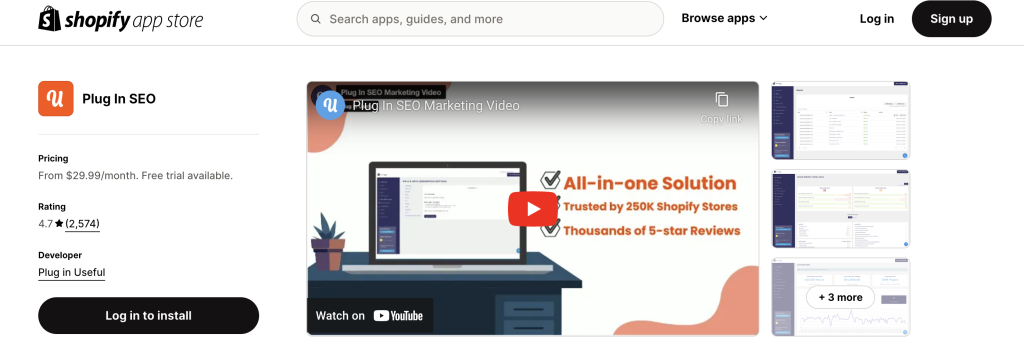
This ensures that your products and services reach your target audience more effectively, resulting in increased traffic and potential sales. Integrating these apps into your Shopify store doesn’t just elevate your search ranking; it opens the door to a continual stream of organic traffic.
Step 10: Preparing for Launch: Final Checklist
Launching your Shopify store is a significant milestone in your ecommerce journey. This final step needs careful attention to detail to make sure your store provides a seamless and delightful shopping experience. A comprehensive pre-launch review acts as your last line of defense against potential issues that could affect your stores performance or your customers’ satisfaction.
Ensuring Your Store is Flawless with a Pre-launch Review
Before going live, take the time to scrutinize every aspect of your store. This includes your site’s design, functionality, and content. Make sure all your web pages load correctly and are free from broken links or images.
Also, ensure that your contact and about us pages are easy to find and contain accurate information. It’s also essential to verify that your store’s checkout process is straightforward and secure for customers, as this plays a critical role in conversion rates.
- Verify that your store is mobile-friendly, as a significant portion of online shopping is done on mobile devices.
- Ensure that your product descriptions are clear, accurate, and appealing, with high-quality images to match.
- Test your site’s speed to make sure it loads quickly, reducing the chance of potential customers leaving out of frustration.
- Double-check that all your legal pages (refund policy, privacy policy, terms of service) are in place and easily accessible.
The Importance of Test Orders
Placing test orders is crucial to understanding the full customer experience on your Shopify store. It not only allows you to verify the functionality of your shopping cart and checkout process but also ensures that your payment gateway is correctly configured, shipping rates are accurately calculated, and tax settings are properly applied. In addition, it gives you an opportunity to review order confirmation and shipping notification emails for accuracy and tone, making sure they align with your brand.
- To initiate test mode for payments, navigate to the “Settings” > “Payments” section of your Shopify admin and enable “Test mode” for your payment provider, if available.
- Walk through the customer journey by adding products to your cart, entering shipping information, and completing checkout using provided test credit card numbers.
- After placing test orders, carefully review the automated emails sent to confirm the order and shipment details are correct and professionally presented.
- Don’t forget to test different shipping addresses to ensure the correct rates are displayed and applied.
- Finally, verify the refund process by refunding a test order, confirming that the process works smoothly and without issues.
Conducting thorough test orders enables you to catch and fix any glitches before they impact your customers. This step is fundamental not only for fine-tuning your store’s technical aspects but also for ensuring a positive customer experience from browsing to unboxing.
By following this detailed checklist, you are setting the stage for a successful store launch. Remember, perfection is a moving target in the ecommerce space; continuous improvement based on customer feedback is key to long-term success. Taking the time to ensure your Shopify store is flawlessly prepared for launch will pay dividends in customer satisfaction and sales performance.
Step 11: Promoting Your Shopify Store
After the launch of your Shopify store, the next immediate step is to draw customers in to convert browsers into buyers. Promoting your Shopify store is an essential element of bringing your ecommerce dream to fruition. At this juncture, your main focus should be on creating a marketing strategy that not only reaches your target audience but also excites and engages them.
From leveraging social media platforms to tapping into the power of email marketing, various channels await to be utilized in your promotional endeavors. This section will guide you through effective strategies to ensure your Shopify store not only garners attention but also retains it, ultimately driving sales and fostering brand loyalty.
Marketing Strategies for a Successful Launch
When it comes to marketing your Shopify store, understanding and implementing a diverse set of strategies is key to your success. Start by identifying your target audience—the foundation of any effective marketing campaign. Knowing your audience means understanding their preferences, needs, and behavior online.
SEO plays a critical role in this, ensuring that your store appears at the top of search engine results pages, making it easier for potential customers to find you. But SEO isn’t just about visibility; it’s about connecting with your audience through high-quality content that speaks to their needs and interests. Content marketing, through blogs, videos, and social media posts, can serve this purpose, helping to build a compelling narrative around your brand.
Paid advertising on channels like Google, Facebook, and Instagram allows for precise targeting and immediate traffic. It’s essential to monitor and adjust these campaigns to maximize their efficacy. Also, influencer collaborations can extend your reach within your niche, introducing your store to relevant audiences in an authentic way.
Finally, don’t overlook the power of email marketing. It’s a direct line to your customers, ideal for promoting products, sharing deals, and connecting with your community. Tailoring your strategy to combine these elements effectively will lay a solid foundation for your promotional efforts, driving both traffic and engagement.
Leveraging Social Media and Email Marketing for Your Shopify Store
Social media marketing is an indispensable tool in the arsenal of a successful Shopify store. It encourages interaction and brand cultivation, offering a platform for storytelling and product showcasing. Begin by choosing social media platforms that resonate most with your demographic.
Instagram and TikTok, for example, are perfect for visually-driven content, while Facebook and LinkedIn may cater to a different, perhaps more mature audience. Creating a consistent posting schedule and engaging with your followers through comments and direct messages can significantly enhance your brand’s presence.
Email marketing complements social media efforts by harnessing the power of direct communication. By collecting email addresses through your website (perhaps through sign-up incentives like discounts or valuable content), you can create targeted campaigns that inform, engage, and encourage purchases.
Utilize Shopify Email to craft visually appealing emails without needing a deep dive into design. Remember, the goal is to add value to your customers’ inbox, not just sell. Whether it’s through exclusive deals, insightful content, or exciting product launches, each email should enrich the connection between your brand and its audience.
By adopting a multifaceted marketing approach that integrates SEO, content marketing, social media, email campaigns, and a commitment to security, you can effectively promote your Shopify store. Each strategy offers unique benefits, and when used in concert, they can significantly amplify your store’s reach, engagement, and conversion rates.
Step 12: Analyzing and Scaling Your Business
Growing your Shopify store is an ongoing process that involves understanding your market, analyzing performance data, and making informed decisions to scale your business effectively. In today’s competitive e-commerce environment, staying ahead requires a mix of strategic planning and flexibility.
Utilizing Shopify Analytics for Growth
Shopify Analytics is a powerful tool that provides insights into your store’s performance, helping you make data-driven decisions.
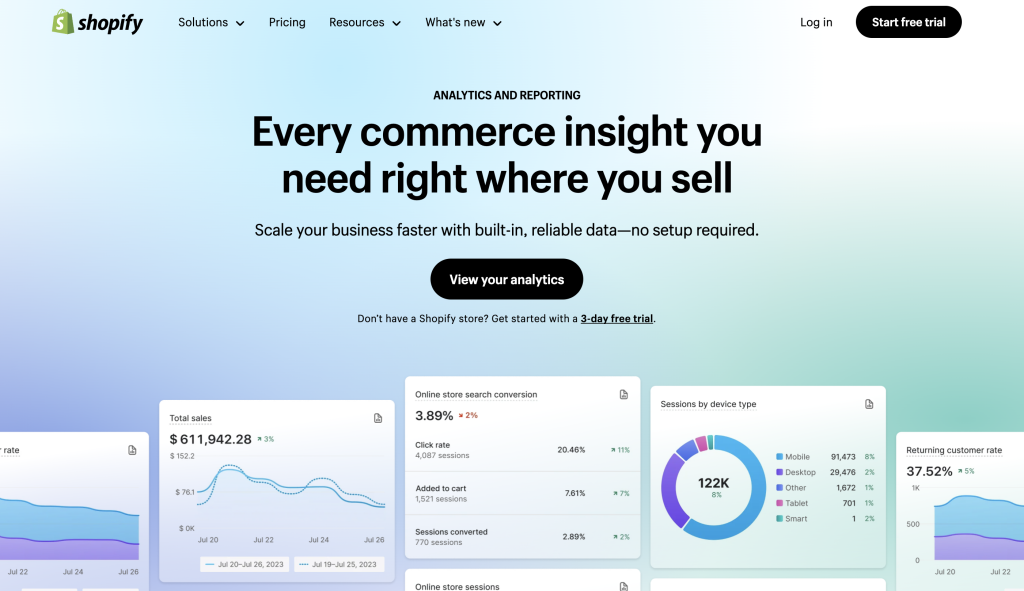
Here are a few ways to leverage Shopify Analytics for growth:
- Track Sales and Customer Behavior: Understand which products are your best sellers and how customers interact with your site. Analyzing sales patterns and customer behavior can help you identify successful products and potential areas for improvement.
- Monitor Marketing Campaigns: Evaluate the effectiveness of your marketing strategies by tracking how they translate into traffic and sales. This allows you to allocate your budget more efficiently and focus on the most profitable channels.
- Analyze Conversion Rates: Identifying where potential customers drop off in the purchasing process can highlight opportunities to optimize your checkout experience and increase conversions.
Utilizing Shopify Analytics helps you understand your customers’ needs and preferences, enabling you to tailor your products, marketing efforts, and overall shopping experience to better meet those needs.
Tips for Scaling Your Shopify Store
Scaling your Shopify store isn’t just about increasing sales – it’s about efficiently managing growth and maintaining or improving your customer’s experience. Here are some practical tips for scaling your business:
- Optimize Your Store’s Design: Ensure your website is user-friendly, mobile-optimized, and visually appealing. A well-designed store can significantly improve customer experience and sales.
- Expand Your Product Lines Carefully: While more products can lead to more sales, it’s important to focus on items that align with your brand and meet your customers’ needs. Use data from Shopify Analytics to guide your decisions on product expansion.
- Enhance Customer Service: As your business grows, maintaining high-quality customer service is essential. Consider implementing chat support, comprehensive FAQs, and ensuring quick response times to inquiries.
- Automate Operations: Use Shopify’s various apps to automate tasks like inventory management, shipping, and email marketing. This helps streamline operations and allows you to focus on strategic growth efforts.
- Continue Marketing Efforts: Even as your business grows, it’s important to keep promoting your store. Invest in SEO, content marketing, and social media to keep attracting new customers.
Scaled growth involves understanding your expanding market and continuously adapting your strategies to meet changing consumer demands and technological advancements. By focusing on data-driven decision-making, customer experience, and efficient operations, you can successfully scale your Shopify store and achieve long-term growth.
Navigating Challenges: Troubleshooting Common Shopify Issues
Running an online store on Shopify can be a smooth journey, but sometimes, you might hit a bump or two along the way. The good news is, most of these challenges have straightforward solutions. Whether you’re dealing with payment and shipping setup problems or looking to boost your store’s speed and performance, this guide aims to provide clear, accessible advice to help you get back on track without the headache.
How to Solve Payment and Shipping Setup Problems
Payment and shipping are core components of your Shopify store, and any hiccup with these can lead to lost sales and customer dissatisfaction. Here are steps to troubleshoot common issues:
- Verify your settings: Always start by checking your settings. Ensure that your payment and shipping options are not only activated but correctly configured to match your business model.
- Update your details: Make sure all your business and bank details are correct and up to date. Incorrect information can lead to unexpected delays or payment processing issues.
- Check for restrictions: Some payment gateways and shipping services have restrictions based on location, product type, or transaction amount. Verify that your products and operations comply with these conditions.
- Consult Shopify Support: If you’re still facing issues, Shopify’s support team is a valuable resource for identifying and solving payment and shipping challenges.
Adjusting these settings can often resolve payment and shipping setup problems, ensuring smoother transactions for your customers.
Improving Store Speed and Performance
A fast and responsive online store is crucial for retaining customers and securing sales. If your Shopify store is lagging, consider the following steps to enhance its speed and performance:
- Optimize images: Large image files can significantly slow down your site. Use image compression tools to reduce file sizes without sacrificing quality.
- Streamline apps: Each app adds to your store’s loading time. Review your installed apps and remove any that are unnecessary or not in use.
- Minimize custom coding: Custom scripts can enhance your site’s functionality, but they can also slow it down. Keep custom code clean and to a minimum.
- Use theme best practices: Choose themes that are optimized for speed, and avoid overloading your site with heavy design elements.
- Conduct regular performance reviews: Tools like Google PageSpeed Insights can help you monitor your site’s speed and recommend improvements.
By following these steps, you can significantly improve your Shopify store’s speed, providing a better shopping experience for your customers. Remember, a fast and efficient site not only ranks better on search engines but also keeps customers coming back.
By addressing these common Shopify challenges with a clear strategy and the right tools, you can enhance your store’s operations, leading to improved customer satisfaction and potentially increased sales.
FAQs: Starting and Growing Your Shopify Store in 2024
What Are the Initial Costs of Starting a Shopify Store?
Beginning a journey with Shopify involves understanding the initial financial commitment. At its core, Shopify offers several subscription plans starting at a nominal fee, making it accessible for entrepreneurs at various levels. Alongside this subscription, costs can include purchasing a domain name, which is essential for brand identity.
The need for any additional applications to enhance store functionality might bring extra expenses. Furthermore, investing in marketing and advertising from the start can significantly aid in driving traffic to your new store. An exclusive offer available includes getting started on Shopify for just $1 for 33 days, coupled with an Online Store Starter Kit, presenting an affordable pathway to launch your online store.
How Long Does It Take to See Sales on My Shopify Store?
The timeline to witness your first sale on Shopify can vary based on several factors, including marketing strategies, store niche, and audience engagement level. Realistically, sales might not be immediate; it can take a few weeks to several months to see the first transaction. Success on Shopify is greatly influenced by consistent marketing efforts, quality of product offerings, and optimizing the customer experience. Persistence and patience, paired with strategic planning and execution, are key to accelerating the path to your first sale.
Can I Run a Shopify Store Without Technical Knowledge?
Yes, launching and managing a Shopify store is designed to be straightforward, catering to entrepreneurs regardless of their technical background. Shopify’s user-friendly interface simplifies store setup, theme customization, and product addition.
For those eager to dive in without much tech know-how, Shopify guides and an extensive knowledge base are available. Plus, Shopify support teams are ready to assist should you encounter any hurdles. This approachability means that creating a professional-looking online store is within reach for anyone motivated to start their ecommerce journey.
How to Choose the Right Apps and Tools for My Shopify Store?
Selecting the appropriate apps and tools for your Shopify store is pivotal in streamlining operations and enhancing customer experience. Start by identifying your store’s specific needs and challenges that could be addressed with apps.
Consider areas such as inventory management, email marketing, customer service, and analytics. With a plethora of options available in the Shopify App Store, focus on apps with high ratings, positive reviews, and compatibility with your current setup. Equally, it’s beneficial to leverage free trials to test out their functionality and impact on your store.
Remember, the goal is to employ apps that simplify processes, add value to your customers, and ultimately contribute to your store’s growth and success.
